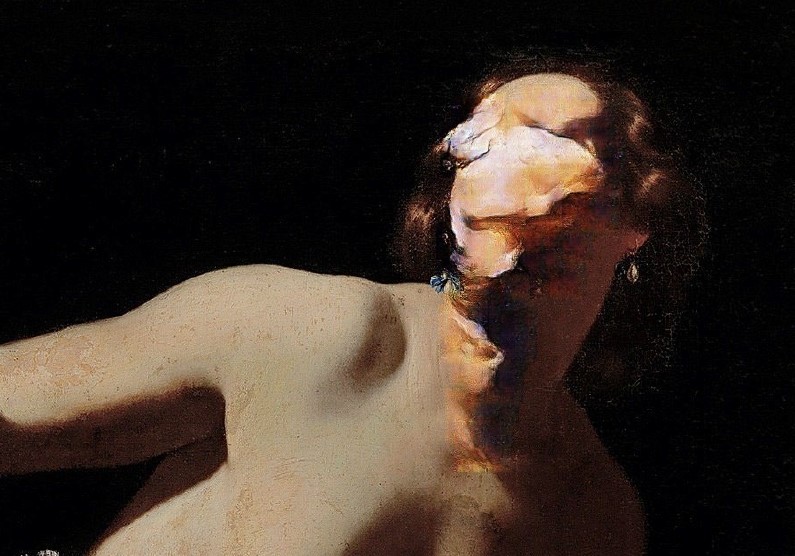Saptarshi Ghosh
Robbie Barrat

Courtesy: Times of Malta
Twenty-two years old Robbie Barrat hardly comes across as an artist. For someone who can almost always be seen dabbling with artificial intelligence (AI), you might mistake him for a computer programmer. Yet, he is one of the youngest artists to have taken the machine learning (ML) art scene by storm. Known for his grotesque and surrealistic AI-generated nude portraits, Barrat uses Generative Adversarial Networks (GANs) to explore creative possibilities in the fields of art history, architecture and fashion. In case you’re wondering, a GAN is a kind of ML made up of two artificial neural networks which compete with each other to generate something new.
Barrat was somewhat a child prodigy; he started working at the American technology company NVIDIA at the age of 17, before becoming a researcher at Stanford University. He soon grew bored and began venturing in the world of AI-generated art.
Initially, Barrat generated fairly realistic landscape paintings using GAN before discovering the aesthetic possibilities of results when the GAN would misinterpret the information. When he started experimenting with nudes, Barrat found that the algorithm was able to “correctly learn ‘rules’ associated with small and local features of paintings (breasts, folds of fat etc) – but failed to learn rules concerning the overall structure of the portraits (two arms, two legs, one head, proportions etc)”. As a result, the algorithm’s imitation of the painted flesh of the figures ended up looking mottled and warped. Barrat’s GAN-generated nudes are disturbing and sinister – a reminder that, to machines, the difference between humans and inanimate objects is just a matter of mere form.
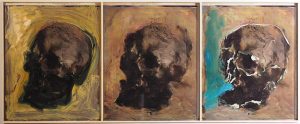
Courtesy: L’Avant Galerie Vossen
Barrat’s first exhibition was in collaboration with the renowned French artist Ronan Barrot and held at the Avant Galerie Vossen in 2019. Titled BARRAT/BARROT: Infinite Skulls, it presented an infinite array of paintings generated after training the algorithm with Barrot’s iconic paintings featuring skulls. Barrot would often ‘correct’ his own paintings by colouring parts of it with orange paint only to fill them back in. This influenced Barrat to create his own series Corrections wherein he trained AI to do the same.
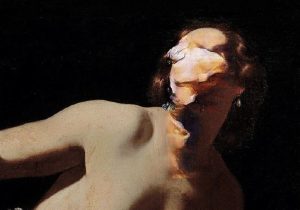
Barrat considers ML to be a tool which cannot function without human intervention: “There’s nothing about the tool which is particularly interesting – there has to be a collaboration with an artist first.”
Harshit Agrawal
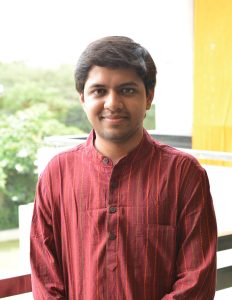
Courtesy: Medium
Harshit Agrawal is an Indian artist, who has been working with artificial intelligence and cutting-edge technologies to create ML-generated artworks since 2015. It was while pursuing his Masters from the MIT Media Lab that he considered combining his passions for AI and art.
Around that period, with the release of AI-powered image generators like Deep Dream and Style Transfer, a small group of artists had already begun experimenting with deep neural networks, creating images that “did not resemble anything [he] had encountered before”. The very concept of engaging in a “creative dialogue” with a machine to make it produce surprising results, was fascinating for him.
Through his art, Agrawal tries to establish an emotional relationship with machines that surround us perpetually. “At this moment, not everyone knows that they are immersed in AI today. And therefore, as an artist, it is very important for me to look at technology [from an emotional] perspective […] Because we are so constantly immersed in it […] making art with AI is highly relevant and important today.”
Apart from exhibiting his work at premier venues like Ars Electronica Festival (Austria), Asia Culture Centre (South Korea), and Museum of Tomorrow (Brazil), Agrawal also holds the distinction of being the only Indian among seven international AI art pioneers, whose works were displayed in one of the first AI art exhibitions worldwide – Gradient Descent (2018) at Nature Morte, New Delhi. Additionally, his works have been nominated twice for the top tech art prize, the Lumen. He recently had his solo exhibition at Emami Art, Kolkata in 2021, titled EXO-stential – AI Musings on the Posthuman, which was curated by Myna Mukherjee.
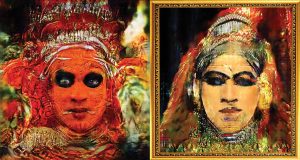
Courtesy: Open Magazine
One of Agrawal’s works is Masked Reality (2019), an interactive piece wherein the viewer’s face morphs to take up the visage of dancers of Kathakali and Theyyam. Each of these South Indian dance forms has a distinct caste identity – while Theyyam is associated with lower-caste groups, Kathakali is performed in upper caste spaces. By transforming each face into its mirror image, Agrawal breaks down caste barriers using AI.
Agrawal has also authored several publications and owns patents for his work at the intersection of AI technology and creative expression.
Sofia Crespo
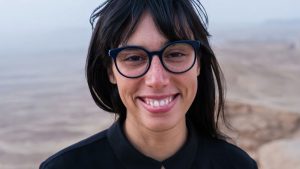
Courtesy: NVIDIA
Sofia Crespo is a renowned digital artist known for her biology-inspired art. Working with AI tools, she creates artificial lifeforms and attempts to collapse rigid boundaries between the natural and the artificial. Organic life forms often use artificial mechanisms to simulate themselves and evolve. This proves that artificial technologies are not separate from nature; rather, they are biased products of biological life.
Born in 1975 in Buenos Aires, Argentina, Crespo got introduced to AI art through a workshop by Gene Kogan. Upon realising that she possessed the required competence, she took the plunge and decided to pursue it professionally. Crespo’s practice is shaped by her interests in ecology and nature. Through her work, she also explores the similarities between the mechanics of AI image generation and the ways in which humans cognitively comprehend their worlds.
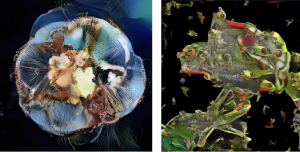
Courtesy: Artnews
Neural Zoo (2018-20) is an acclaimed series by Crespo, which she describes as “speculative nature”. Upon training it with datasets of images from the natural world, the GAN generated visuals of hybrid creatures, neither real nor unreal: Crespo’s surreal ecosystem is populated with frogs resembling flowers, iridescent jellyfishes with visible internal organs and other fantastical beings. “What a neural network does is extract the textures from a dataset, and create a new image from that,” explains Crespo.
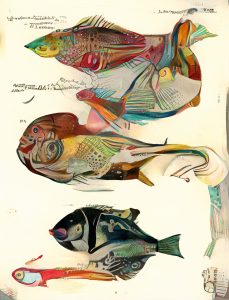
Courtesy: Colossal
Beneath the Neural Waves (2021) is another project by Crespo, which presents a digital ecosystem populated with artificial lifeforms, along with various sculptural fragments, imagery and text. The work demonstrates how our physical and virtual realities get entangled in our experience of nature.
Helena Sarin

Courtesy: NVIDIA
Helena Sarin dons the hat of both a visual artist and a software engineer. Born in Moscow, Sarin trained in computer science from the Moscow Civil Engineering University. Currently she is settled in the US after living in Israel for several years. Sarin has always worked with the most advanced technologies – she designed communication systems at Bell Labs and has been an independent consultant for developing computer vision software using deep learning, for the last few years.
While working in the technology industry, Sarin has always dabbled parallels in the applied arts, like fashion and food styling. Additionally, she also did commissioned work in pastels and watercolour. Art and technology never intersected in Sarin’s life until in 2016, when she came across GAN during a client project. Soon, she was training GAN with her own photography and artworks.
As part of her practice, Sarin always works with small datasets composed of her own sketches, ink drawings, engravings and photographs. When fed into the GANs, they regurgitate images that lie between the digital and the analogue. In her AI-generated works, one can even detect particularities of the specific media she had used in the analogue works – traces of pastels, newspapers and photographs – which lend a palimpsest quality to them.
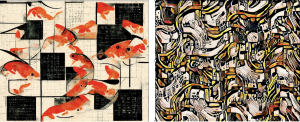
Courtesy: This Is Paper
Sarin’s approach to her medium is like that of any other artist’s, characterised by loads of experimentation and painstaking observation. Often working with still lifes, she frequently uses food, flowers, vases, bottles and other “bricolage”, as she calls it, in her practice. Sarin also explores unifying patterns in nature and computation through GANs, which, she believes, reveal some of these patterns and rearrange them in interesting ways.
During the pandemic, Sarin worked on a few artists’ books – The Book of GANesis, GANcommedia Erudita and The Book of veGAN – each featuring her own ML art. Since 2021, she is working on #potteryGAN, a project involving clayware development using GAN interface.
Bibliography
- https://nightcafe.studio/blogs/info/ai-artist-spotlight-robbie-barrat
- https://www.itsnicethat.com/features/ones-to-watch-2020-robbie-barrat-digital-240220
- https://www.artnews.com/list/art-in-america/features/gans-and-nfts-1234594335/robbie-barrat-ai-generated-nude-portrait/
- https://medium.com/tech-art-talks/a-cyborg-artist-in-the-metaverse-2da753ba1bb5
- https://www.bizzbuzz.news/amp/bizz-talk/meet-harshit-agarwal-who-uses-artificial-intelligence-to-create-art-1044443
- https://www.nvidia.com/en-us/research/ai-art-gallery/artists/harshit-agrawal/
- https://nightcafe.studio/blogs/info/ai-artist-spotlight-sofia-crespo
- https://sofiacrespo.com/
- https://www.artnews.com/art-in-america/features/sofia-crespo-speculative-nature-1234614511/amp/
- https://www.artnome.com/news/2018/11/14/helena-sarin-why-bigger-isnt-always-better-with-gans-and-ai-art
- https://www.nvidia.com/en-us/research/ai-art-gallery/artists/helena-sarin/
- https://www.neuralbricolage.com/more-about

